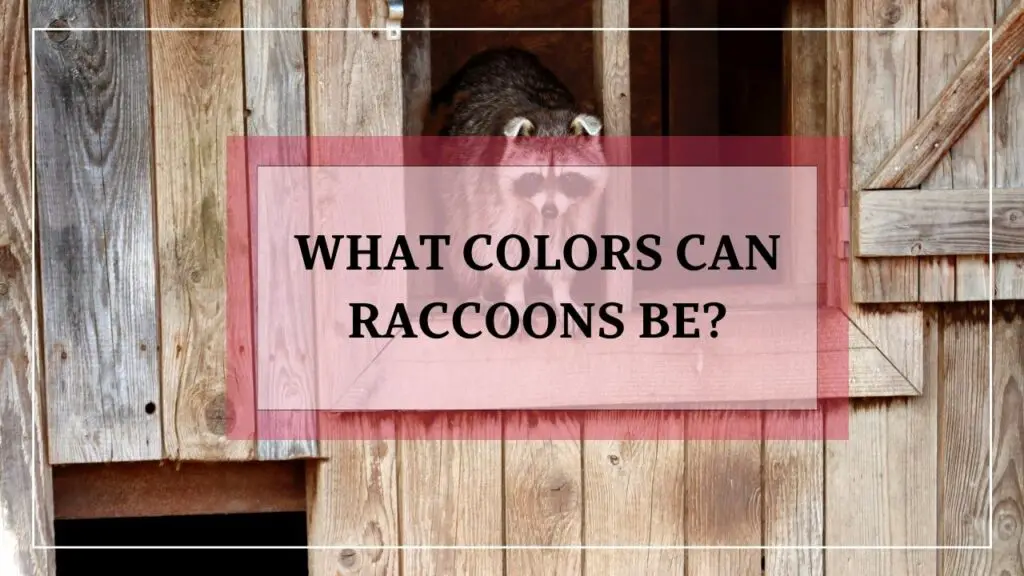Raccoons are fascinating creatures that live in North America. They are known for their distinct features like their black mask around the eyes and their bushy tails with rings. But have you ever wondered what colors raccoons can be? Well, raccoons usually have a mix of black, gray, and brown fur. This combination helps them blend in with their surroundings, like forests and city parks. Sometimes, you might even spot a rare albino raccoon, which has white fur and pinkish eyes. These colors help raccoons stay safe and hidden from predators. So, next time you see a raccoon, remember that they come in different shades, just like the colors of a beautiful painting!
The Typical Coloration of Raccoons
A. Grayish Fur
Raccoons are known for their beautiful grayish fur, which is their most common coloration. This gray hue helps them blend seamlessly into their surroundings, especially in urban areas where they often roam. You might even mistake them for a pile of trash from a distance! But don’t worry, they’re much cuter than that!
B. Black Mask
One of the most distinctive features of raccoons is their black mask pattern on their face. It’s like they’re ready for a fancy masquerade! This black mask serves a purpose beyond just looking stylish though. It actually helps with their social interactions and communication. It’s believed that the black mask helps raccoons recognize each other and convey their emotions through facial expressions. So, next time you see a raccoon with a mask, remember they’re not trying to rob a bank, they’re just expressing themselves!
C. Ringed Tail
Now let’s talk about their tails…or should I say, their fancy rings! Raccoons have a unique ringed pattern on their tails, which adds an extra touch of style to their overall appearance. While the exact function of these rings isn’t fully understood, they may serve as a form of visual communication or even help with camouflage. So, next time you see a raccoon wiggling its tail, they might just be saying “hello” or trying to blend in with the background. Who knew raccoons were so fashion-forward?
Factors Affecting Raccoon Coloration
A. Genetics and Inheritance
Have you ever wondered why raccoons come in different colors? Well, it turns out that genetics play a big role in determining their color variations. Just like humans inherit certain traits from their parents, raccoons inherit their color genes too. These genes determine whether a raccoon will have grayish fur, a black mask, or even a unique pattern on their tail.
Related Article:Can Bobcats Be Different Colors?
The inheritance patterns of raccoon color traits can be quite interesting. For example, the grayish fur is a dominant trait, meaning that if a raccoon has one parent with gray fur, it is likely to have gray fur as well. On the other hand, the black mask and ringed tail patterns are controlled by different sets of genes, which can lead to variations in these traits among raccoon populations.
B. Environmental Factors
While genetics play a significant role in raccoon coloration, environmental factors can also have an impact. Think about it – just like how the food we eat can affect our health, the diet of a raccoon can influence its color. Raccoons that consume more carotenoid-rich foods, like fruits and vegetables, may have brighter or more vibrant fur colors.
Additionally, the habitat and climate that raccoons live in can also influence their coloration. Raccoons living in heavily forested areas might have darker fur to help them blend in with the shadows, while those in open grasslands might have lighter fur to match their surroundings. So, it’s not just about genetics – the environment plays a role too!
C. Evolutionary Significance
Now, you might be wondering why raccoons have such diverse colors in the first place. Well, it all comes down to evolution. Different colorations can provide adaptive advantages in different environments. For example, a raccoon with grayish fur might be better camouflaged in urban areas, where there are lots of gray buildings and concrete.
Related Article:Can Raccoons See Colors?
On the other hand, a raccoon with a black mask might have better social communication within its group. The mask can help other raccoons identify individuals and understand their intentions, sort of like a raccoon “name tag.” So, while it may seem like just a matter of aesthetics, raccoon coloration actually has evolutionary significance!
So, the next time you spot a raccoon with a unique color, remember that it’s not just a random fluke – there are genetics, environmental factors, and even evolutionary reasons behind it. Nature is pretty amazing, isn’t it?
Common Misconceptions about Raccoon Colors
A. White Raccoons
Now, let’s address one of the most common misconceptions about raccoon colors: white raccoons. You may have heard stories or seen pictures of white raccoons, but the truth is, they are usually albino or piebald raccoons. Albino raccoons have a genetic condition that causes them to lack pigmentation, resulting in their white fur and pink eyes. Piebald raccoons, on the other hand, have patches of white fur mixed with their usual coloration.
True white raccoons, where their entire body is completely white, are incredibly rare and often misidentified. So, if you think you’ve spotted a white raccoon, make sure to take a closer look and consider whether it might actually be an albino or piebald raccoon.
B. Blue Raccoons
Another misconception that occasionally pops up is the existence of blue raccoons. However, let me clear this up for you: there are no naturally occurring blue raccoons in the wild. If you’ve seen pictures or heard stories of blue raccoons, chances are it’s either due to lighting conditions or some creative photo editing.
Related Article:Can Raccoons Be Pets?
Raccoons typically display shades of gray, brown, and black in their fur, so a blue raccoon would definitely be an interesting sight. But alas, it’s just a figment of the imagination or a trick of the camera lens.
Now that we’ve debunked these misconceptions, let’s appreciate the true range of colors that raccoons can come in. From their classic grayish fur to the striking patterns of albino and piebald raccoons, these creatures never fail to surprise and captivate us with their unique colorations. So, the next time you spot a raccoon, take a moment to appreciate its beautiful coat and remember the fascinating world of color variations that these creatures inhabit.
FAQs
What colors can raccoons be?
Raccoons typically have a black and grayish coat with a distinctive pattern of rings on their tail. However, their fur can vary in color, ranging from brown to reddish or even blonde. It is important to note that the coloration of raccoons can differ based on their geographical location and subspecies.
Are albino raccoons common?
No, albino raccoons are not common. Albinism is a genetic condition that results in the absence of pigment in an animal’s fur, skin, and eyes. While albino raccoons do exist, they are relatively rare. Albinism affects the ability of animals to camouflage and can make them more vulnerable to predators.
Can raccoons change their fur color?
No, raccoons cannot change their fur color. Unlike some animals that can change their coat color seasonally, such as arctic hares, raccoons do not have the ability to alter their fur color. The coloration of a raccoon’s fur remains consistent throughout its life.
Related Article:Can Raccoons Be Friendly?
Conclusion
In conclusion, raccoon colors are truly fascinating and offer a glimpse into the diverse world of animal coloration. From the typical grayish fur to the distinct black mask and ringed tail, raccoons have evolved unique traits that aid in their survival and communication. However, there are also uncommon color variations, such as albino, melanistic, and piebald raccoons, which add even more intrigue to their appearance.
The color variations seen in raccoons are influenced by a combination of genetics and environmental factors. Genes play a significant role in determining raccoon color variations, with different traits being inherited in different ways. Environmental conditions, such as diet, habitat, and climate, can also impact raccoon coloration.
Understanding the evolutionary significance of raccoon color variations is an ongoing area of research. Different colorations may provide benefits and adaptive advantages in different environments, aiding in camouflage, social interactions, or communication.
It is important to address common misconceptions about raccoon colors, such as white or blue raccoons. True white raccoons are usually albino or piebald, while blue raccoons are not a natural coloration. These misconceptions often arise due to misidentification or lighting conditions.
As animal enthusiasts, let us appreciate the diverse colors of raccoons and continue to learn about the fascinating world of animal colorations. The study of raccoon colors not only enhances our understanding of these clever creatures but also provides insights into the wider field of animal biology and evolution.
Related Article:Can Raccoons Be Relocated?



